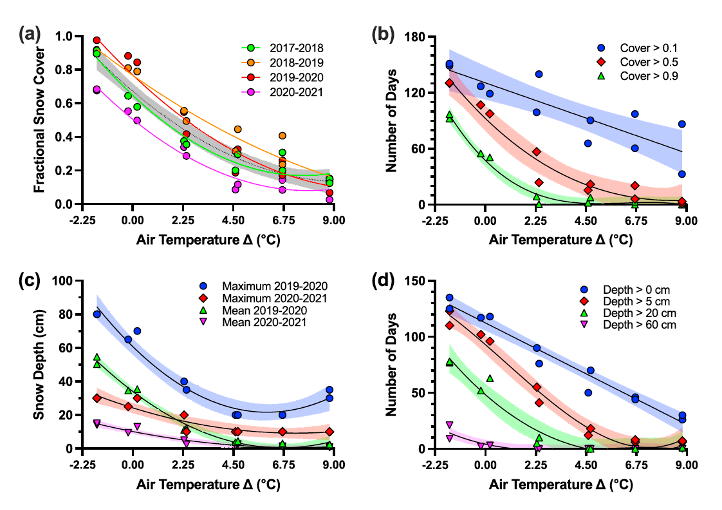March 15, 2024
Critical Snow Cover Quantification Enabled by DOE’s SPRUCE Experiment
Snow cover changes from warming impact surface energy balance with impacts on hydrology.

Effects of Spruce and Peatland Responses Under Changing Environments warming treatments on integrated measures of snow cover and snow depth.
[Reprinted under a Creative Commons Attribution 4.0 International License (CC BY 4.0) from Richardson, A. D., et al. "Experimental Whole-Ecosystem Warming Enables Novel Estimation of Snow Cover and Depth Sensitivities to Temperature, and Quantification of the Snow-Albedo Feedback Effect." Journal of Geophysical Research: Biogeosciences 129 (3), e2023JG007833 (2024). DOI:10.1029/2023JG007833.]
The Science
Climate change is reducing the amount, duration, and extent of snow across high-latitude ecosystems. But, in landscapes where persistent winter snow cover develops, experimental platforms to specifically investigate interactions between warming and changes in snowpack and impacts on ecosystem processes, have been lacking.
Experimental warming observations at the large-scale Spruce and Peatland Responses Under Changing Environments (SPRUCE) study in northern Minnesota enabled direct quantification of how future climate change will influence snowpack and associated hydrology of important ecosystems.
The Impact
Results showed how future warming at levels consistent with the Intergovernmental Panel on Climate Change projections will result in transformative changes to the winter season in boreal peatlands, with impacts on how these ecosystems function and their impact on the climate system.
Summary
A team of researchers used the SPRUCE study, an active field warming experiment, to disentangle changes in winter precipitation forms under plausible future winter warming. Even modest levels of warming had severe negative impacts on snow variables. For example, warming of just +2°C was sufficient to reduce the number of winter days with a 5 cm snowpack by about 50%. Reductions in snow cover have feedback effects on local winter climate because shrub‐covered ground reflects less solar energy than snow‐covered ground. Researchers estimated that because of this so‐called “snow‐albedo feedback,” maximum daytime air temperature will be elevated by up to about 1°C above snow‐free ground when compared to snow‐covered ground.
Principal Investigator
Paul Hanson
Oak Ridge National Laboratory
hansonpj@ornl.gov
Program Manager
Daniel Stover
U.S. Department of Energy, Biological and Environmental Research (SC-33)
Environmental System Science
daniel.stover@science.doe.gov
Funding
This material is based upon work supported by the Biological and Environmental Research program within the U.S. Department of Energy’s (DOE) Office of Science. Oak Ridge National Laboratory is managed by UT‐Battelle, LLC, for DOE under contract DE‐AC05‐00OR22725.
Related Links
References
Richardson, A. D., et al. "Experimental Whole-Ecosystem Warming Enables Novel Estimation of Snow Cover and Depth Sensitivities to Temperature, and Quantification of the Snow-Albedo Feedback Effect." Journal of Geophysical Research: Biogeosciences 129 (3), e2023JG007833 (2024). https://doi.org/10.1029/2023JG007833.

